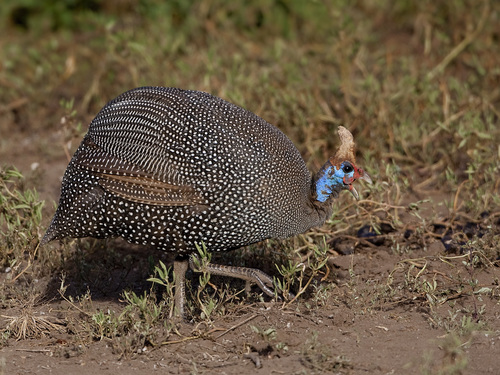
Helmeted Guineafowl
The Helmeted Guineafowl (*Numida meleagris*) is a striking and unique bird species native to Africa, known for its distinctive bony casque on top of its head. It plays a crucial role in its ecosystem, primarily as a seed disperser and insect controller. Beyond its ecological importance, the Helmeted Guineafowl has also been domesticated and is found in various parts of the world, valued for its meat and eggs. In some African cultures, it is associated with folklore and traditional medicine.
53-58 cm
Length
Not Evaluated cm
Wingspan
Least Concern
Conservation Status
Distribution
Primarily found in sub-Saharan Africa, with introduced populations in the West Indies, parts of North America, and Europe. Their range extends from south of the Sahara to parts of South Africa. They are largely non-migratory, though some populations may move locally in response to food availability and rainfall.
Lifespan
Up to 12 years in the wild, potentially longer in captivity.
Helmeted Guineafowl's Habitat
Habitat Types
Savannas, Grasslands, Shrublands, Open woodlands, Agricultural areas
Climate Zones
Tropical, Subtropical, Semi-arid
Adaptations
Their strong legs and feet are adapted for running and scratching the ground in search of food. The casque may play a role in thermoregulation or in dominance displays, although its exact function is still debated.
Variations
Several subspecies are recognized, differing slightly in plumage and casque size, reflecting adaptations to local environments. For example, West African populations may differ subtly from those in East or Southern Africa.
Appearance
Breeding Plumage
Plumage is generally consistent year-round.
Seasonal Feather Changes
No significant seasonal variation.
Sex Based Plumage Differences
Males and females have very similar plumage.
Notable Features
Bony casque on the head, Unfeathered, bluish-gray face and neck, Dark gray plumage covered in dense white spots, Red wattles on the sides of the face
Diet and Feeding
Primary Foods
Seeds, Insects, Berries, Roots, Small invertebrates
Foraging Behavior
Forages on the ground by scratching with its strong feet and pecking at food items. Often forages in groups, moving systematically across the landscape.
Specializations
Strong gizzard to help process hard seeds and tough insect exoskeletons.
Seasonal Diet Variations
Diet shifts with seasonal availability. During the wet season, insects may be more prevalent, while seeds and roots are more important during the dry season.
Behavior
Social Structure
Highly social, often found in flocks of 20-30 birds, sometimes larger outside the breeding season.
Communication
Loud, repetitive calls, Contact calls to maintain flock cohesion, Alarm calls to warn of predators
Migration
Generally non-migratory, but may undertake local movements in response to food and water availability.
Territorial or Group Behaviors
During the breeding season, males may become territorial, defending nesting areas. Outside of breeding, flocks maintain a social hierarchy.
Conservation
Threats
Habitat loss due to agriculture, Hunting for food and traditional medicine, Pesticide use in agricultural areas
Protection Programs
Some protected areas within their range, Community-based conservation initiatives in some regions
Local National Laws
Varies by country; some have hunting regulations, while others offer no specific protection.
Population Trend
Stable
Population Estimates
Widespread and relatively common, though precise population numbers are difficult to obtain.
Interesting Facts
They are excellent runners
Helmeted Guineafowl prefer to run from danger rather than fly, and can reach speeds of up to 20 km/h.
They are often found near herds of grazing mammals
They benefit from the insects disturbed by the grazing animals.
The eggs are very thick-shelled.
This helps to protect them from damage in the simple ground nest and from predators.
Faqs about Helmeted Guineafowl
Can Helmeted Guineafowl fly?
Yes, they can fly, but they prefer to run. They typically only fly short distances when startled or to roost in trees at night.
Are Helmeted Guineafowl related to chickens?
They are both in the order Galliformes, but they are in different families. Guineafowl are in the family Numididae, while chickens are in the family Phasianidae.
Are Helmeted Guineafowl noisy?
Yes, they are known for their loud, distinctive calls, which can be heard over long distances.
Copyright @ Nature Style Limited. All Rights Reserved.
 English
English